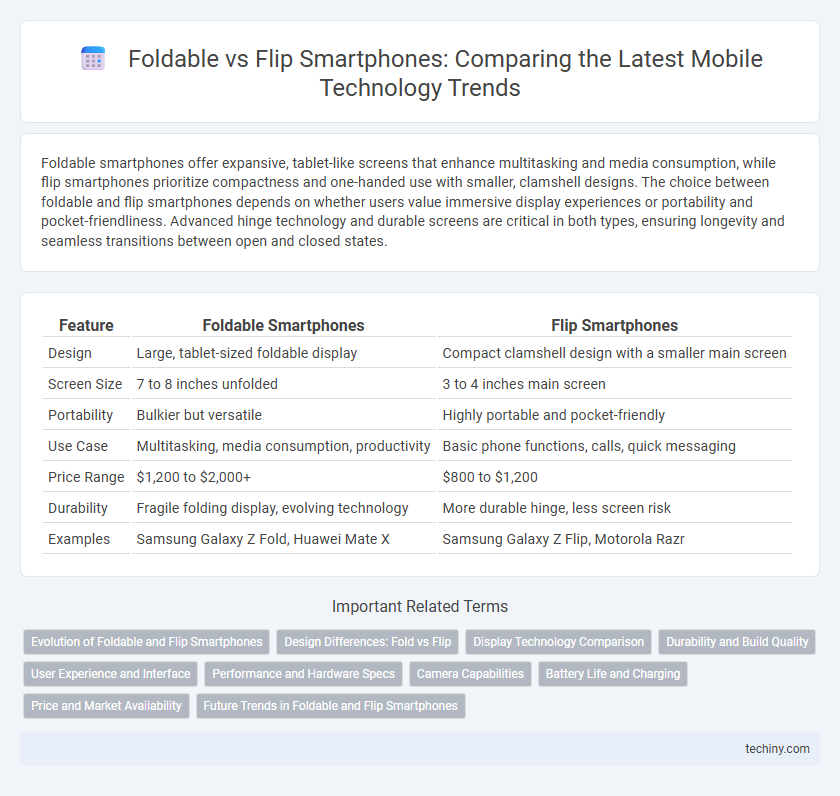Foldable smartphones offer expansive, tablet-like screens that enhance multitasking and media consumption, while flip smartphones prioritize compactness and one-handed use with smaller, clamshell designs. The choice between foldable and flip smartphones depends on whether users value immersive display experiences or portability and pocket-friendliness. Advanced hinge technology and durable screens are critical in both types, ensuring longevity and seamless transitions between open and closed states.
Table of Comparison
| Feature | Foldable Smartphones | Flip Smartphones |
|---|---|---|
| Design | Large, tablet-sized foldable display | Compact clamshell design with a smaller main screen |
| Screen Size | 7 to 8 inches unfolded | 3 to 4 inches main screen |
| Portability | Bulkier but versatile | Highly portable and pocket-friendly |
| Use Case | Multitasking, media consumption, productivity | Basic phone functions, calls, quick messaging |
| Price Range | $1,200 to $2,000+ | $800 to $1,200 |
| Durability | Fragile folding display, evolving technology | More durable hinge, less screen risk |
| Examples | Samsung Galaxy Z Fold, Huawei Mate X | Samsung Galaxy Z Flip, Motorola Razr |
Evolution of Foldable and Flip Smartphones
Foldable and flip smartphones have rapidly evolved, driven by advancements in flexible OLED display technology and hinge mechanisms that enhance durability and user experience. Early foldable models like the Samsung Galaxy Fold introduced large, tablet-sized screens, while flip smartphones such as the Motorola Razr revived compact designs with modern foldable screens. Innovations in materials and software optimization continue to refine both categories, pushing the boundaries of portable device versatility and form factor innovation.
Design Differences: Fold vs Flip
Foldable smartphones feature a larger, tablet-sized display that folds inward or outward along a horizontal hinge, offering expansive screen real estate for multitasking and media consumption. Flip smartphones, often referred to as flip or clamshell designs, use a vertical hinge to fold the screen into a compact form factor resembling traditional flip phones, prioritizing portability and pocketability. The fold design emphasizes maximizing display area for productivity, while flip design focuses on compactness without sacrificing the full touchscreen experience.
Display Technology Comparison
Foldable smartphones utilize flexible OLED displays that enable seamless expansion from phone-sized screens to tablet-sized displays, offering immersive viewing experiences with high resolution and vibrant colors. Flip smartphones typically feature clamshell designs with compact, rigid OLED or AMOLED screens that fold inward, prioritizing portability while maintaining standard smartphone display quality. Advances in ultra-thin glass and hinge mechanisms optimize durability and screen crease minimization in both foldable and flip display technologies.
Durability and Build Quality
Foldable smartphones typically feature larger flexible OLED displays with reinforced ultra-thin glass, enhancing durability against everyday wear while maintaining immersive screen real estate. Flip smartphones use a clamshell design with a smaller foldable display, often reinforced by hinge mechanisms designed to withstand tens of thousands of folds, prioritizing compactness and ease of pocketability. Both designs employ advanced materials such as stainless steel frames and Gorilla Glass Victus, balancing build quality with resistance to scratches, drops, and hinge fatigue.
User Experience and Interface
Foldable smartphones offer a seamless tablet-like display that enhances multitasking and immersive media consumption, while flip smartphones prioritize compactness and one-handed use with a clamshell design. The user interface on foldables adapts dynamically to larger screens, providing split-screen functionality and optimized app layouts, whereas flip smartphones emphasize quick access features and notifications on their smaller outer displays. Both designs improve user experience by balancing screen real estate with portability, tailored to different usage preferences.
Performance and Hardware Specs
Foldable smartphones typically feature larger AMOLED displays with higher resolutions and more advanced processors like the Snapdragon 8 Gen 2, delivering superior multitasking and gaming performance. Flip smartphones prioritize compact design with durable hinge mechanisms, often equipped with mid-tier chips such as the Snapdragon 7 series, balancing efficient everyday use and portability. Both device types incorporate comparable RAM options, but foldables generally offer enhanced battery capacity and more sophisticated cooling systems for sustained high performance.
Camera Capabilities
Foldable smartphones typically offer advanced multi-lens camera systems with wider apertures and larger sensors, enhancing image quality and low-light performance. Flip smartphones often feature high-resolution front-facing cameras optimized for selfies, benefiting from their clamshell design to act as a camera cover. Both designs incorporate AI-driven imaging technologies, but foldables generally provide more versatile camera setups for professional-grade photography.
Battery Life and Charging
Foldable smartphones typically feature larger batteries ranging from 4,000 to 5,000mAh, supporting extended usage but often consuming more power due to expansive displays. Flip smartphones usually have smaller batteries around 3,000 to 3,500mAh, balancing compact form factors with moderate battery life. Both designs increasingly incorporate fast charging technologies, with foldables often equipped with higher wattage chargers for quicker battery replenishment.
Price and Market Availability
Foldable smartphones generally carry higher price tags, often exceeding $1,000 due to advanced hinge mechanisms and flexible display technology, while flip smartphones typically offer more affordable options starting around $600. Market availability for foldables is concentrated among premium brands like Samsung and Huawei, with limited variants focused on flagship consumers, whereas flip phones see broader market penetration including mid-range phones from multiple manufacturers. Consumer demand and production costs influence pricing disparities, with foldables aimed at tech enthusiasts and flip phones appealing to budget-conscious users seeking compact form factors.
Future Trends in Foldable and Flip Smartphones
Foldable and flip smartphones are leveraging advancements in flexible OLED displays and hinge durability to enhance user experience and device longevity. Emerging trends include integration of 5G connectivity, under-display cameras, and AI-driven adaptive interfaces tailored for multitasking and immersive media consumption. Market forecasts predict increased adoption driven by improved battery technology and innovative form factors that blend portability with expanded screen real estate.
Foldable vs Flip Smartphone Infographic

 techiny.com
techiny.com